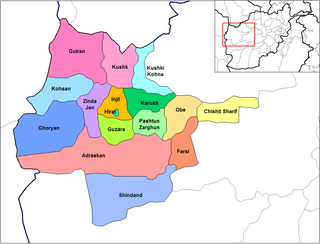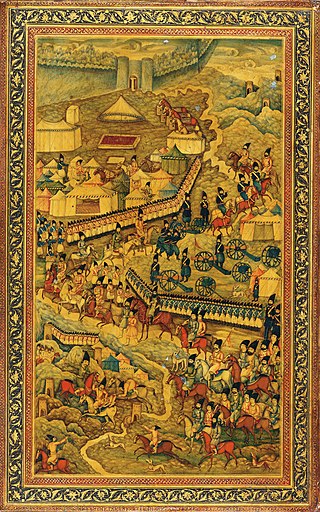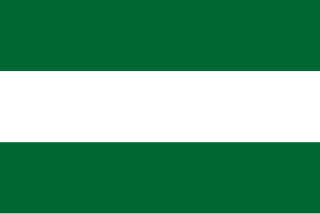
Abdur Rahman Khan also known by his epithets, The Iron Amir, was Amir of Afghanistan from 1880 to his death in 1901. He is known for perpetrating the Hazara Genocide, but also uniting the country after years of internal fighting and negotiation of the Durand Line Agreement with British India.

Herat is one of the thirty-four provinces of Afghanistan, located in the western part of the country. Together with Badghis, Farah, and Ghor provinces, it makes up the north-western region of Afghanistan. Its primary city and administrative capital is Herat City. The province of Herat is divided into about 17 districts and contains over 2,000 villages. It has a population of about 3,780,000, making it the second most populated province in Afghanistan behind Kabul Province. The population is multi-ethnic but largely Persian-speaking. Herat dates back to the Avestan times and was traditionally known for its wine. The city has a number of historic sites, including the Herat Citadel and the Musalla Complex. During the Middle Ages Herat became one of the important cities of Khorasan, as it was known as the Pearl of Khorasan.

Dost Mohammad Khan Barakzai, nicknamed the Amir-i Kabir, was the founder of the Barakzai dynasty and one of the prominent rulers of Afghanistan during the First Anglo-Afghan War. With the decline of the Durrani dynasty, he became the Emir of Afghanistan in 1826. An ethnic Pashtun, he belonged to the Barakzai tribe. He was the 11th son of Payinda Khan, chief of the Barakzai Pashtuns, who was killed in 1799 by King Zaman Shah Durrani.

Afghanistan is divided into 34 provinces. The provinces of Afghanistan are the primary administrative divisions. Each province encompasses a number of districts or usually over 1,000 villages.

Farah is one of the 34 provinces of Afghanistan, located in the southwestern part of the country on the border with Iran. It is a spacious and sparsely populated province, divided into eleven districts and contains hundreds of villages. It has a population of about 563,026, which is multi-ethnic and mostly a rural tribal society. The Farah Airport is located near the city of Farah, which serves as the capital of the province. Farah is linked with Iran via the Iranian border town of Mahirud. The famous tourism sites of the province include Pul Garden, New Garden, Kafee Garden, shrine of Sultan Amir and Kafer castle.

Sher Ali Khan was Amir of Afghanistan from 1863 to 1866 and from 1868 until his death in 1879. He was one of the sons of Dost Mohammed Khan, founder of the Barakzai dynasty in Afghanistan.
Sultan Ahmad Khan b. Sardar 'Azim Muhammadzai, also known as Sultan Jan was the ruler of the Principality of Herat from September 1857 to April 1863. He was a nephew of Dost Mohammad Khan. In 1855-56, Sultan Ahmad Khan sent a petition to the Shah, Nasir al-Din. If the Iranians would support Sultan Ahmad Khan with an army, he would overthrow the Amir-i Kabir and incorporate Afghanistan into the Guarded Domains. However, Sultan Ahmad Khan was intercepted by Dost Mohammad Khan, who exiled Sultan Ahmad Khan to Iran.

North Khorasan province is one of the 31 provinces of Iran, located in the northeast of the country. Its capital is the city of Bojnord.

South Khorasan province is one of the 31 provinces of Iran, located in the eastern part of the country. Its capital is the city of Birjand. In 2014, the province was placed in Region 5.
Farah is the capital and largest city of Farah Province in western Afghanistan. It is located on the Farah River, close to the border with Iran. It is one of the largest cities of western Afghanistan in terms of population, with about 1.5 million people living in its urban area.

Shinḍanḍ District is located in the southern part of Herat Province in Afghanistan, bordering Adraskan District to the north, Ghor Province to the east and Farah Province to the south and west. It is one of the 16 districts of Herat Province. The name Shindand is Pashto and relates to lush green farming area. In Persian language it translates to Sabzwār.

Alakozai is a Pashtun tribe in Afghanistan. They are one of the four tribes of the Zirak tribal confederacy of Durrani Pashtuns.
The Taymani are an Aimaq people in Ghor Province in central Afghanistan. They speak the Aimaq dialect of Persian, but some southern groups of Taymanis speak the Pashto language. The Taymani people claim descent Kakar Pashtuns.

Turkestan Province was a province in Afghanistan.

The First Herat War was an attack on the Principality of Herat by Qajar Iran during the Great Game. Herat was held by Kamran Shah and his vizier Yar Mohammad Khan Alakozai. The Shah of Persia was Mohammed Shah Qajar. Four Europeans were involved: the British, Sir John McNeill and Eldred Pottinger as well as the Russians, Count Simonich and Jan Prosper Witkiewicz. Sher Mohammad Khan Hazara, an ally of Kamran and chieftain of the Qala-e Naw Hazaras, helped form a Sunni confederacy of Aimaq, Turkmen, and Uzbek tribes and played a crucial role in defending Herat when the city was besieged. The siege ended when neither side gained a clear advantage, the British threatened to take military action and the Russians withdrew their support.

The 207th 'Zafar' (Victory) Corps was a corps of the Afghan National Army. It was headquartered at Camp Zafar, Herat, in Herat Province in the west of Afghanistan.
The 2019 Afghanistan Provincial Challenge Cup was a List A cricket competition that took place in Afghanistan between 31 July and 10 August 2019. It was the third year of domestic List A cricket to be played in Afghanistan, following the announcements by the International Cricket Council (ICC) in February and May 2017. Eight teams qualified for the tournament, and were divided into two groups of four.

The Herat campaign of 1862–1863 was a conflict between the Principality of Herat and the Emirate of Afghanistan, from March 1862, when Sultan Jan captured Farah from the Muhammadzai Emirs and continued through the 10-month long siege of Herat, ending on May 27, 1863, when the city fell to the Amir-i Kabir, thus completing the unification of Afghanistan.

The Principality of Herat, the Emirate of Herat, the Herat Khanate or simply Herat was a state in Afghanistan from 1793 to 1863, and one of the three main khanates that existed in 19th century Afghanistan after the breakup of the Durrani Empire.
The Afghan Civil War was fought from 9 June 1863 to January 1869. It began as a result of Dost Mohammad Khan's death on 9 June 1863 and the subsequent power struggles among his sons. Dost Mohammad consolidated his power in the second half of his reign within his inner family. His sons were appointed governors of provinces and effectively acted autonomous from the central government. This would inevitably lead to his sons fighting for control after his death.















